研究生英语综合教程(上)Unit_ 5
- 格式:ppt
- 大小:1.47 MB
- 文档页数:13
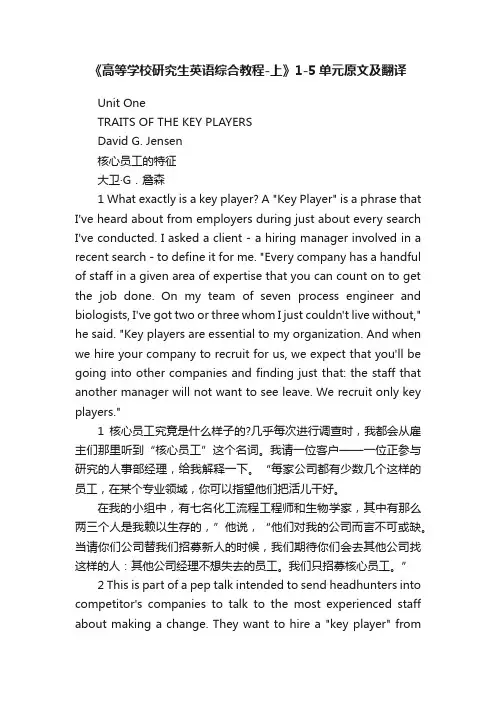
《高等学校研究生英语综合教程-上》1-5单元原文及翻译Unit OneTRAITS OF THE KEY PLAYERSDavid G. Jensen核心员工的特征大卫·G.詹森1 What exactly is a key player? A "Key Player" is a phrase that I've heard about from employers during just about every search I've conducted. I asked a client - a hiring manager involved in a recent search - to define it for me. "Every company has a handful of staff in a given area of expertise that you can count on to get the job done. On my team of seven process engineer and biologists, I've got two or three whom I just couldn't live without," he said. "Key players are essential to my organization. And when we hire your company to recruit for us, we expect that you'll be going into other companies and finding just that: the staff that another manager will not want to see leave. We recruit only key players."1核心员工究竟是什么样子的?几乎每次进行调查时,我都会从雇主们那里听到“核心员工”这个名词。

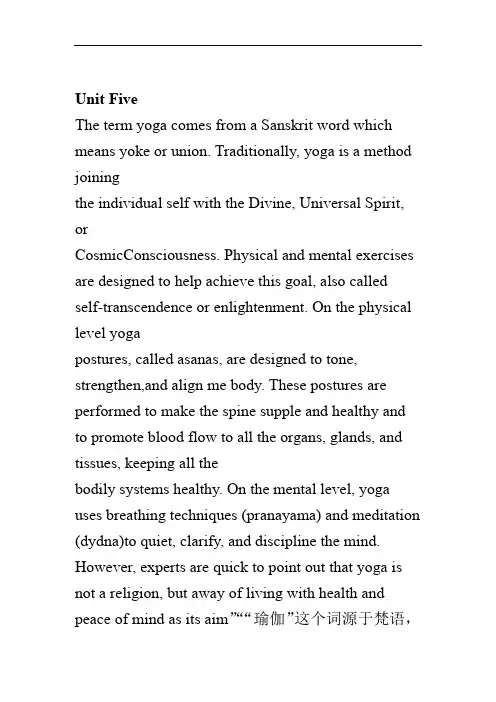
Unit FiveThe term yoga comes from a Sanskrit word which means yoke or union. Traditionally, yoga is a method joiningthe individual self with the Divine, Universal Spirit, orCosmicConsciousness. Physical and mental exercises are designed to help achieve this goal, also calledself-transcendence or enlightenment. On the physical level yogapostures, called asanas, are designed to tone, strengthen,and align me body. These postures are performed to make the spine supple and healthy and to promote blood flow to all the organs, glands, and tissues, keeping all thebodily systems healthy. On the mental level, yoga uses breathing techniques (pranayama) and meditation (dydna)to quiet, clarify, and discipline the mind. However, experts are quick to point out that yoga is not a religion, but away of living with health and peace of mind as its aim”““瑜伽”这个词源于梵语,意思是结合”或联合“s.万物之灵或无穷的意传统上瑜伽是一种把个人和神,识联合在一起的方法。
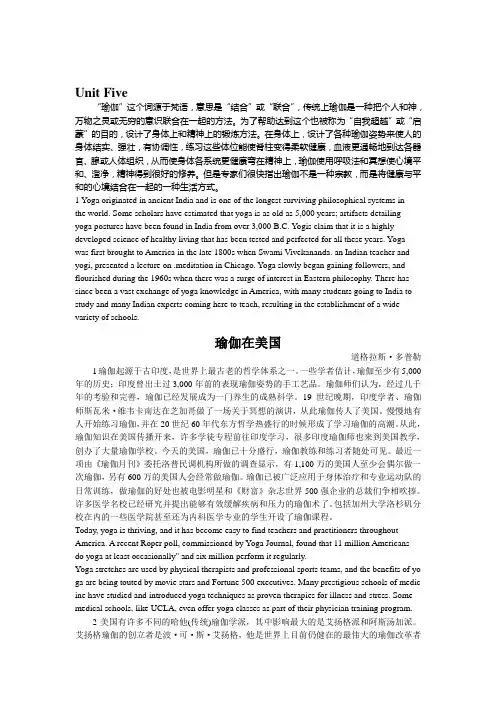
Unit Five“瑜伽”这个词源于梵语,意思是“结合”或“联合”,传统上瑜伽是一种把个人和神,万物之灵或无穷的意识联合在一起的方法。
为了帮助达到这个也被称为“自我超越”或“启蒙”的目的,设计了身体上和精神上的锻炼方法。
在身体上,设计了各种瑜伽姿势来使人的身体结实、强壮,有协调性,练习这些体位能使脊柱变得柔软健康,血液更通畅地到达各器官、腺或人体组织,从而使身体各系统更健康穹在精神上,瑜伽使用呼吸法和冥想使心境平和、澄净,精神得到很好的修养。
但是专家们很快指出瑜伽不是一种宗教,而是将健康与平和的心境结合在一起的一种生活方式。
1 Yoga originated in ancient India and is one of the longest surviving philosophical systems inthe world. Some scholars have estimated that yoga is as old as 5,000 years; artifacts detailing yoga postures have been found in India from over 3,000 B.C. Yogis claim that it is a highly developed science of healthy living that has been tested and perfected for all these years. Yoga was first brought to America in the late 1800s when Swami Vivekananda. an Indian teacher and yogi, presented a lecture on .meditation in Chicago. Yoga slowly began gaining followers, and flourished during the 1960s when there was a surge of interest in Eastern philosophy. There has since been a vast exchange of yoga knowledge in America, with many students going to India to study and many Indian experts coming here to teach, resulting in the establishment of a wide variety of schools.瑜伽在美国道格拉斯·多普勒1瑜伽起源于古印度,是世界上最古老的哲学体系之一。
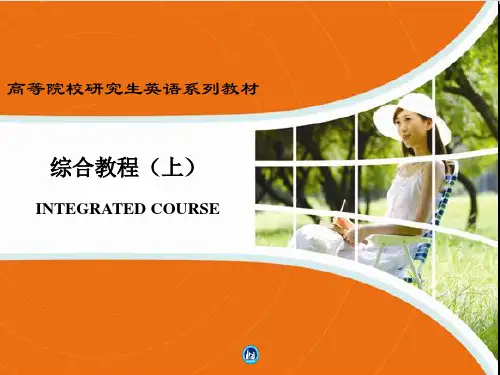

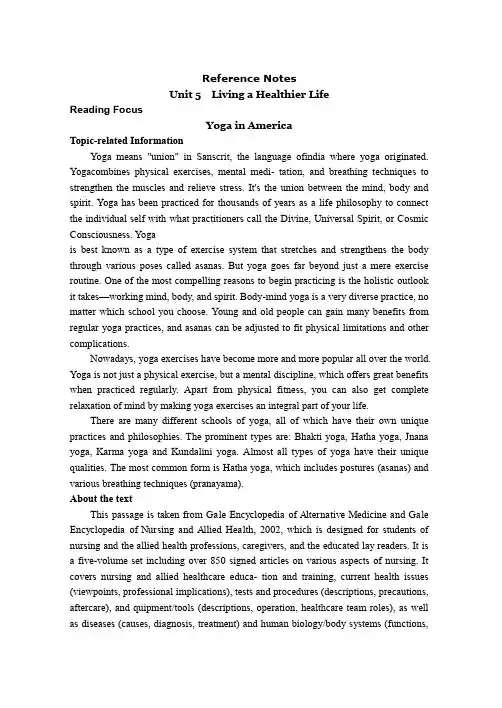
Reference NotesUnit 5 Living a Healthier LifeReading FocusYoga in AmericaTopic-related InformationYoga means "union" in Sanscrit, the language ofindia where yoga originated. Yogacombines physical exercises, mental medi- tation, and breathing techniques to strengthen the muscles and relieve stress. It's the union between the mind, body and spirit. Yoga has been practiced for thousands of years as a life philosophy to connect the individual self with what practitioners call the Divine, Universal Spirit, or Cosmic Consciousness. Yogais best known as a type of exercise system that stretches and strengthens the body through various poses called asanas. But yoga goes far beyond just a mere exercise routine. One of the most compelling reasons to begin practicing is the holistic outlook it takes—working mind, body, and spirit. Body-mind yoga is a very diverse practice, no matter which school you choose. Young and old people can gain many benefits from regular yoga practices, and asanas can be adjusted to fit physical limitations and other complications.Nowadays, yoga exercises have become more and more popular all over the world. Yoga is not just a physical exercise, but a mental discipline, which offers great benefits when practiced regularly. Apart from physical fitness, you can also get complete relaxation of mind by making yoga exercises an integral part of your life.There are many different schools of yoga, all of which have their own unique practices and philosophies. The prominent types are: Bhakti yoga, Hatha yoga, Jnana yoga, Karma yoga and Kundalini yoga. Almost all types of yoga have their unique qualities. The most common form is Hatha yoga, which includes postures (asanas) and various breathing techniques (pranayama).About the textThis passage is taken from Gale Encyclopedia of Alternative Medicine and Gale Encyclopedia of Nursing and Allied Health, 2002, which is designed for students of nursing and the allied health professions, caregivers, and the educated lay readers. It is a five-volume set including over 850 signed articles on various aspects of nursing. It covers nursing and allied healthcare educa- tion and training, current health issues (viewpoints, professional implications), tests and procedures (descriptions, precautions, aftercare), and quipment/tools (descriptions, operation, healthcare team roles), as well as diseases (causes, diagnosis, treatment) and human biology/body systems (functions,role in human health). The book focuses primarily on the interests of nurses and allied health professionals. The essays were contributed by physicians, nurses, and other health professionals.This passage is an expository essay on yoga. It gives a brief introduction to the origin of yoga, its quick spread in the US, as well as the benefits of doing yoga. The author also talks about the different schools of yoga and their focuses. At the same time, he gives the beginners of yoga some tips for practice.Since the passage is an exposition, long sentences and passive voice are used a lot. However, the author makes a point of writing in clear language so readers will fully understand him.参考译文“瑜伽”这个词源于梵语,意思是“结合”或“联合”。
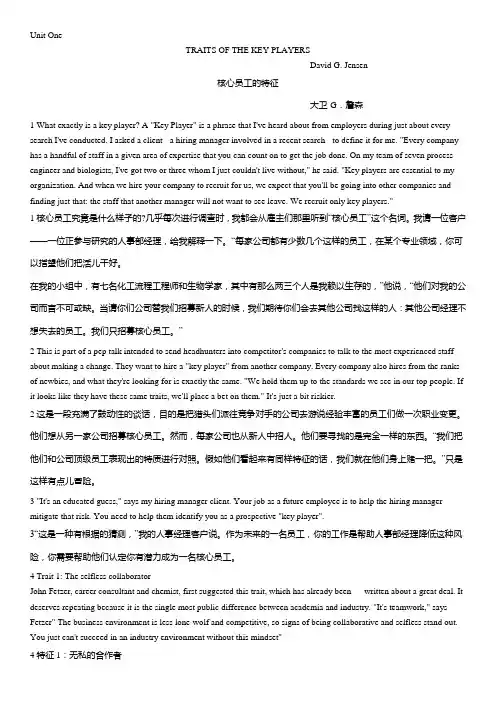
Unit OneTRAITS OF THE KEY PLAYERSDavid G. Jensen核心员工的特征大卫·G.詹森1 What exactly is a key player? A "Key Player" is a phrase that I've heard about from employers during just about every search I've conducted. I asked a client - a hiring manager involved in a recent search - to define it for me. "Every company has a handful of staff in a given area of expertise that you can count on to get the job done. On my team of seven process engineer and biologists, I've got two or three whom I just couldn't live without," he said. "Key players are essential to my organization. And when we hire your company to recruit for us, we expect that you'll be going into other companies and finding just that: the staff that another manager will not want to see leave. We recruit only key players."1核心员工究竟是什么样子的?几乎每次进行调查时,我都会从雇主们那里听到“核心员工”这个名词。
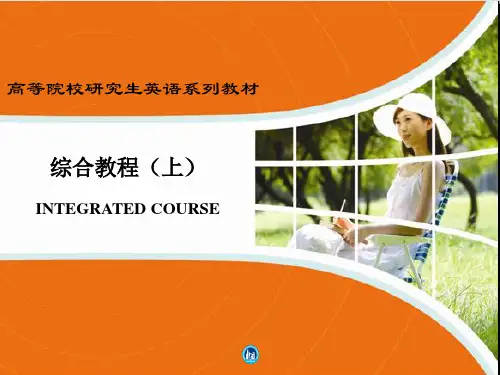

Unit Five“瑜伽”这个词源于梵语,意思是“结合”或“联合”,传统上瑜伽是一种把个人和神,万物之灵或无穷的意识联合在一起的方法。
为了帮助达到这个也被称为“自我超越”或“启蒙”的目的,设计了身体上和精神上的锻炼方法。
在身体上,设计了各种瑜伽姿势来使人的身体结实、强壮,有协调性,练习这些体位能使脊柱变得柔软健康,血液更通畅地到达各器官、腺或人体组织,从而使身体各系统更健康穹在精神上,瑜伽使用呼吸法和冥想使心境平和、澄净,精神得到很好的修养。
但是专家们很快指出瑜伽不是一种宗教,而是将健康与平和的心境结合在一起的一种生活方式。
1 Yoga originated in ancient India and is one of the longest surviving philosophical systems inthe world. Some scholars have estimated that yoga is as old as 5,000 years; artifacts detailing yoga postures have been found in India from over 3,000 B.C. Yogis claim that it is a highly developed science of healthy living that has been tested and perfected for all these years. Yoga was first brought to America in the late 1800s when Swami Vivekananda. an Indian teacher and yogi, presented a lecture on .meditation in Chicago. Yoga slowly began gaining followers, and flourished during the 1960s when there was a surge of interest in Eastern philosophy. There has since been a vast exchange of yoga knowledge in America, with many students going to India to study and many Indian experts coming here to teach, resulting in the establishment of a wide variety of schools.瑜伽在美国道格拉斯·多普勒1瑜伽起源于古印度,是世界上最古老的哲学体系之一。

Unit FiveThe term yoga comes from a Sanskrit word which means yoke or union. Traditionally, yoga is a method joiningthe individual self with the Divine, Universal Spirit, orCosmicConsciousness. Physical and mental exercises are designed to help achieve this goal, also calledself-transcendence or enlightenment. On the physical level yogapostures, called asanas, are designed to tone, strengthen,and align me body. These postures are performed to make the spine supple and healthy and to promote blood flow to all the organs, glands, and tissues, keeping all thebodily systems healthy. On the mental level, yoga uses breathing techniques (pranayama) and meditation (dydna)to quiet, clarify, and discipline the mind. However, experts are quick to point out that yoga is not a religion, but away of living with health and peace of mind as its aim”““瑜伽”这个词源于梵语,意思是结合”或联合“s.万物之灵或无穷的意传统上瑜伽是一种把个人和神,识联合在一起的方法。
Reference NotesUnit 5 Living a Healthier LifeReading FocusYoga in AmericaTopic-related InformationYoga means "union" in Sanscrit, the language ofindia where yoga originated. Yogacombines physical exercises, mental medi- tation, and breathing techniques to strengthen the muscles and relieve stress. It's the union between the mind, body and spirit. Yoga has been practiced for thousands of years as a life philosophy to connect the individual self with what practitioners call the Divine, Universal Spirit, or Cosmic Consciousness. Yoga is best known as a type of exercise system that stretches and strengthens the body through various poses called asanas. But yoga goes far beyond just a mere exercise routine. One of the most compelling reasons to begin practicing is the holistic outlook it takes—working mind, body, and spirit. Body-mind yoga is a very diverse practice, no matter which school you choose. Young and old people can gain many benefits from regular yoga practices, and asanas can be adjusted to fit physical limitations and other complications.Nowadays, yoga exercises have become more and more popular all over the world. Yoga is not just a physical exercise, but a mental discipline, which offers great benefits when practiced regularly. Apart from physical fitness, you can also get complete relaxation of mind by making yoga exercises an integral part of your life.There are many different schools of yoga, all of which have their own unique practices and philosophies. The prominent types are: Bhakti yoga, Hatha yoga, Jnana yoga, Karma yoga and Kundalini yoga. Almost all types of yoga have their unique qualities. The most common form is Hatha yoga, which includes postures (asanas) and various breathing techniques (pranayama).About the textThis passage is taken from Gale Encyclopedia of Alternative Medicine and Gale Encyclopedia of Nursing and Allied Health , 2002, which is designed for students of nursing and the allied health professions, caregivers, and the educated lay readers. It is a five-volume set including over 850 signed articles on various aspects of nursing. It covers nursing and allied healthcare educa- tion and training, current health issues (viewpoints, professional implications), tests and procedures (descriptions, precautions, aftercare), and quipment/tools (descriptions, operation, healthcare team roles), as well as diseases (causes, diagnosis, treatment) and human biology/body systems (functions, role in human health). The book focuses primarily on the interests of nurses and allied healthprofessionals. The essays were contributed by physicians, nurses, and other health professionals.This passage is an expository essay on yoga. It gives a brief introduction to the origin of yoga, its quick spread in the US, as well as the benefits of doing yoga. The author also talks about the different schools of yoga and their focuses. At the same time, he gives the beginners of yoga some tips for practice.Since the passage is an exposition, long sentences and passive voice are used a lot. However, the author makes a point of writing in clear language so readers will fully understand him.参考译文“瑜伽”这个词源于梵语,意思是“结合”或“联合” 。
Unit FiveThe term yoga comes from a Sanskrit word which mean s yoke or union. Traditionally, yoga is a method joining the individual self with the Divine, Universal Spirit, or CosmicConsciousness. Physical and mental exercises ar e designed to help achieve this goal, also called self-tran scendence or enlightenment. On the physical level yoga postures, called asanas, are designed to tone, strengthen, and align me body. These postures are performed to ma ke the spine supple and healthy and to promote blood fl ow to all the organs, glands, and tissues, keeping all the bodily systems healthy. On the mental level, yoga uses b reathing techniques (pranayama) and meditation (dydna )to quiet, clarify, and discipline the mind. However, exp erts are quick to point out that yoga is not a religion, but away of living with health and peace of mind as its aim s. “瑜伽”这个词源于梵语,意思是“结合”或“联合”传统上瑜伽是一种把个人和神,万物之灵或无穷的意识联合在一起的方法。
研究生英语综合教程英语原文Unit5Unit Five The term yoga comes from a Sanskrit word which means yoke or union.Traditionally, yoga is a method joining the individual self with the Divine, Universal Spirit, or CosmicConsciousness. Physical and mental exercises are designed to help achieve this goal, also called self-transcendence or enlightenment. On the physical level yoga postures, called asanas, are designed to tone, strengthen, ana align me body. These postures are performed to make the spine supple and healthy and to promote blood flow to all the organs, glands, and tissues, keeping all the bodily systems healthy. On the mental level, yoga uses breathing techniques (pranayama) and meditation (dydna) to quiet, clarify, and discipline the mind. However, experts are quick to point out that yoga is not a religion, but away of living with health and peace of mind as its aims.YOGA IN AMERICA Douglas Dupler1 Yoga originated in ancient India and is one of the longest surviving philosophical systems in the world. Some scholars have estimated that yoga is as old as 5,000 years; artifacts detailing yoga postures have been found in India from over 3,000 B.C. Yogis claim that it is a highly developed science of healthy living that has been tested and perfected for all these years. Yoga was first brought to America in the late 1800s when Swami Vivekananda. an Indian teacher and yogi, presented a lecture on .meditation in Chicago. Yoga slowly began gaining followers, and flourished during the 1960s when there was a surge of interest in Eastern philosophy. There has since been a vast exchange of yoga knowledge in America, with many studentsgoing to India to study and many Indian experts coming here to teach, resulting in the establishment of a wide variety of schools.Today, yoga is thriving, and it has become easy to find teachers and practitioners throughout America. A recent Roper poll, commissioned by Yoga Journal, found that 11 million Americans do yoga at least occasionally" and six million perform it regularly. Yoga stretches are used by physical therapists and professional sports teams, and the benefits of yoga are being touted by movie stars and Fortune 500 executives. Many prestigious schools of medicine have studied and introduced yoga techniques as proven therapies for illness and stress. Some medical schools, like UCLA, even offer yoga classes as part of their physician training program.2 There are several different schools of hatha yoga in America; the two most prevalent ones are Iyengar and Ashtanga yoga8. Iyengar yoga was founded by B.K.S. Iyengar, who is widely considered as one of the great living innovators of yoga. Iyengar yoga puts strict emphasis on form and alignment, and uses traditional hatha yoga techniques in new manners and sequences. Iyengar yoga can be good for physical therapy because it allows the use of props like straps and blocks to make it easier for some people to get into the yoga postures. Ashtanga yoga can be a more vigorous routine, using a flowing and dance-like sequence of hatha postures to generate body heat, which purifies the body through sweating and deep breathing.3 Yoga routines can take anywhere from 20 minutes to two or more hours, with one hour being a good time investment to perform a sequence of postures and a meditation. Some yoga routines, depending on the teacher and school, can be as strenuous as the most difficult workout, and some routinesmerely stretch and align the body while the breath and heart rate are kept slowand steady. Yoga achieves its best results when it is practiced as a daily discipline, and yoga can be a life-long exercise routine, offering deeper and more challenging positions as a practitioner becomes more adept. The basic positions can increase a person's strength, flexibility and sense of well being almost immediately. but it can take years to perfect and deepen them, which is an appealing and stimulating aspect of yoga for many.4 Yoga is usually best learned from a yoga teacher or physical therapist, but yoga is simple enough that one can learn the basics from good books on the subject, which are plentiful. Yoga classes are generally inexpensive, averaging around 10 dollars per class, and students can learn basic postures in just a few classes. Many YMCAs, colleges, and community healthorganizations offer beginning yoga classes as well, often for nominal fees. If yoga is part of a physical therapy program,' it can be .reimbursed by insurance.5 Yoga can also provide the same benefits as any well-designed exercise program, increasing general health and stamina reducing stress. and improving those conditions brought about by sedentary lifestyles. Yoga has the added advantage of being a low- impact activity that uses only gravity as resistance, which makes it an excellent physical therapy routine: certain yoga postures can be safely used to strengthen and balance allparts of the body.6 Meditation has been much studied and approved for its benefits in reducing stresses- related conditions. The landmark book, The Relaxation Response, by Harvard cardiologist Herbert Benson, showed that meditation and breathing techniques forrelaxation could have the opposite effect of stress, reducing blood pressure and other indicators, Since then, much research has reiterated the benefits of meditation for stress reduction and general health. Currently, the American Medical Association recommends meditation techniques as a first step before medication for borderline hypertension cases.7 Modern psychological Studies have shown that even slight facial expressions can cause changes in the involuntary nervous system; yoga utilizes the mind/body connection, that is, yoga practice contains the central ideas that physical posture and alignment can influence a person's mood and self-esteem, and also that the mind can be used to shape and heal the body. Yoga practitioners claim that the strengthening of mind/body awareness can bring eventual improvements in all facets of a person's life.8 Yoga can be performed by those of any age and condition, although not all poses should be attempted by everyone. Yoga is also a very accessible form of exercise; all that is needed is a flat floor surface large enough to stretch out on, a mat or towel, and enough overhead space to full raise the arms. It is a good activity for those who can't go to gyms, who don' t like other forms of exercise, or have, very busy schedules. Yoga should be done on an empty stomach, and teachers recommend waiting three or more hours after meals. Loose and comfortable clothing should he worn.9 Beginners should exercise care and concentration when performing yoga postures, and not try to stretch too much too quickly, as injury could result. Some advanced yoga postures, like the headstand and full lotus position, can be difficult and require strength, flexibility, and gradual preparation, so beginners shouldget the help of a teacher before attempting them.10 Yoga is not a competitive sport; it does not matter how a person does in comparison with others, but how aware and disciplined one becomes with one's own body and limitations. Proper form and alignment should always be maintained during a stretch or posture, and the stretch or posture should be stopped when there is pain, dizziness, or fatigue. The mental component ofyoga is just as important as the physical postures. Concentration and awareness breath should not be neglected. Yoga should be done with an open, gentle, and non-critical mind: when one stretches into a position, it can be thought of as accepting and working on one's limits. Impatience, self-criticism and comparing oneself to others will not help in this process of self-knowledge. While performing the yoga of breathing (pranayama) and meditation (dyana), it is best to have an experienced teacher, as these powerful techniques can cause dizziness and discomfort when done improperly.11 Although yoga originated in a culture very different from modern America, it has been accepted and its practice has spread relatively quickly. Many yogis are amazed at how rapidly yoga's popularity has spread in America, considering the legend that it was passed down secretly by handfuls or adherents tor many centuries.12 There can still be found some resistance to yoga, for active and busy Americans sometimes find it hard to believe that an exercise program that requires them to slow down, concentrate, and breathe deeply can be more effective than lifting weights or running, However, ongoing research in top medical schools is showing yoga's effectiveness for overall health and for specificproblems, making it an increasingly acceptable health practice.。